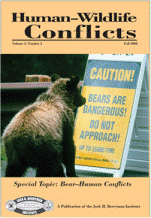To accomplish this goal we have collaborated with Digital Commons and Utah State University libraries to provide our readers and authors the very best in publication support and service (see http://digitalcommons.usu.edu/hwi/).
Human–Wildlife Interactions (ISSN 2155-3858 print; ISSN 2155-3874 online) is a peer-reviewed journal published two times a year by the Jack H. Berryman Institute, Department of Wildland Resources, Utah State University, Logan, Utah 84322-5230. Material appearing in Human–Wildlife Interactions may not be reproduced in any form without the written consent of the publisher.
Editor-in-Chief: Terry Messmer
Managing Editor: Rosanna Vaili
Human–Wildlife Interactions
Berryman Institute
Department of Wildland Resources
Utah State University, Box 5230
Logan, Utah 84322-5230 United States
2007
Why this journal was created, Johan T. du Toit
Perceptions of wildlife damage and species conservation: lessons learned from the Utah prairie dog, R. Dwayne Elmore, Terry A. Messmer, and Mark W. Brunson
Adaptive and economic management methods for feral hog control in Florida, Richard M. Engeman, Bernice U. Constantin, Stephanie A. Schwiff, Henry T. Smith, John Woolard, John Allen, and John Dunlap
An extraordinary patch of feral hog damage in Florida before and after initiating hog removal, Richard M. Engeman, John Woolard, Henry T. Smith, Jean Bourassa, Bernice U. Constantin, and Daniel Griffin
Public opinion, the Leopold Report, and the reform of federal predator control policy, James W. Feldman
Successful use of neck snares to live-capture red foxes, S. Nicole Frey, Michael R. Conover, and Gary Cook
Distribution and disease prevalence of feral hogs in Missouri, R. Edwin Hartin, Mark R. Ryan, and Tyler A. Campbell
Hazing of Canada geese is unlikely to reduce nuisance populations in urban and suburban communities, Robin A. Holevinski, Paul D. Curtis, and Richard A. Malecki
In Memory, Spring 2007, Human-Wildlife Conflicts
Land-use pattern, urbanization, and deer–vehicle collisions in Alabama, Anwar Hussain, James B. Armstrong, David B. Brown, and John Hogland
Influence of habitat patch characteristics on the success of upland duck nests, Jaiume M. Jiménez, Michael R. Conover, Raymond D. Deuser, and Terry A. Messmer
Feral hog research in western Louisiana: expanding populations and unforeseen consequences, Michael D. Kaller, James D. Hudson III, Eric C. Achberger, and William E. Kelso
Crop diversifi cation leads to diverse bird problems in Hawaiian agriculture, Marni E. Koopman and William C. Pitt
Berryman Institute addresses feral hog problems, Bruce D. Leopold
The Director’s desk, Bruce D. Leopold
Book Review: The beast in the garden: a modern parable of man and nature, Nicole McCoy
Use of snares to live-capture beavers, Lance B. McNew, Jr.; Clayton K. Nielson; and Craig K. Bloomquist
Range size, habitat use, and dial activity of feral hogs on reclaimed surface-mined lands in east Texas, Robert C. Mersinger and Nova J. Silvy
Evolution of the field of wildlife damage management in the United States and future challenges, James E. Miller
20,25-Diazacholesterol as an oral contraceptive for black-tailed prairie dog population management, Paul Nash, Carol A. Furcolow, Kimberly S. Bynum, Christi A. Yoder, Lowell A. Miller, and John J. Johnston
Comparison of sampling strategies to estimate abundance of double-crested cormorants in western Mississippi, Aaron T. Pearse, Brian S. Dorr, Stephen J. Dinsmore, and Richard M. Kaminski
A review of Shiga toxin Escherichia coli and Salmonella enterica in cattle and free-ranging birds: potential association and epidemiological links, Kerri Pedersen and Larry Clark
Population viability analysis of monk parakeets in the United States and examination of alternative management strategies, Stephen Pruett-Jones, James R. Newman, Christian M. Newman, Michael L. Avery, and James R. Lindsay
Appreciating feral hogs: extension education for diverse stakeholders in Texas, Dale Rollins, Billy J. Higginbotham, Kenneth A. Cearly, and R. Neal Wilkins
Birth control is not for everyone: a response, Allen T. Rutberg
Comparison of 2 vegetation-height management practices for wildlife control at airports, Thomas W. Seamans, Scott C. Barras, Glen E. Bernhardt, Bradley F. Blackwell, and Jonathon D. Cepek
Book Review: Living with coyotes: managing predators humanely using food aversion conditioning, John A. Shivik
Eliminating trapping escalates beaver complaints and costs to the public, Robert Southwick
Expanding bear populations bring new challenges to state wildlife agencies, Robert Southwick
Scent deterrence to reduce southern flying squirrel kleptoparasitism of red-cockaded woodpecker cavities, Jonathon M. Stober and L. Mike Conner
Deer–human conflict and hunter access in an exurban landscape, Daniel J. Storm, Clayton K. Nielson, Eric M. Shauber, and Alan Woolf
Foraging preferences of captive Canada geese related to turfgrass mixtures, Brian E. Washburn, Scott C. Barras, and Thomas W. Seamans
Developing people skills in the human–wildlife conflict community, Ben C. West
The role of knowledge in developing people skills, Ben C. West
Using predator exclosures to protect ground nests from red fox, Ben C. West, Terry A. Messmer, and Dominic C. Bachman

